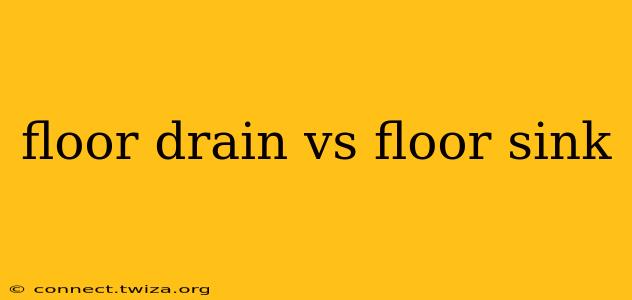Choosing between a floor drain and a floor sink might seem like a minor detail during a renovation or new construction project, but understanding the key differences can significantly impact functionality, aesthetics, and maintenance. Both serve the purpose of draining water from the floor, but their design, applications, and overall suitability vary greatly. This guide will clarify the distinctions between floor drains and floor sinks, helping you make the informed decision best suited to your needs.
What is a Floor Drain?
A floor drain is a simple, typically unassuming, drainage point embedded in the floor. It's primarily designed for efficient water removal, often in areas prone to spills or moisture, such as showers, laundry rooms, and garages. Floor drains generally consist of a grate covering a drainpipe connected to the main plumbing system. They're usually less expensive and easier to install than floor sinks.
Advantages of Floor Drains:
- Cost-effective: Floor drains are generally cheaper to purchase and install than floor sinks.
- Simple design: Their straightforward design ensures easy maintenance and cleaning.
- Effective drainage: They provide efficient drainage for water, preventing pooling and potential water damage.
- Discreet: Floor drains often have a low profile, blending seamlessly into the floor.
Disadvantages of Floor Drains:
- Limited functionality: Floor drains primarily serve as drainage points and don't offer additional features like a basin or storage.
- Potential for odor: If not properly sealed and maintained, floor drains can emit unpleasant odors.
- Not suitable for all applications: Floor drains aren't ideal for situations requiring a basin or a place to rinse or wash items.
What is a Floor Sink?
A floor sink, also known as a floor drain with a basin, combines the drainage function of a floor drain with an integrated basin. This provides a small, built-in sink, useful for cleaning tools, rinsing items, or even hand washing in certain applications. Floor sinks are more complex in design and typically found in commercial settings like workshops, garages, or industrial kitchens, though they are increasingly appearing in high-end residential applications.
Advantages of Floor Sinks:
- Added functionality: The integrated basin adds versatility, providing a place to wash hands, clean tools, or rinse items.
- Improved hygiene: The basin allows for washing and cleaning without directly contacting the floor drain.
- Aesthetic appeal: In some settings, a floor sink can add a sophisticated touch to the space.
Disadvantages of Floor Sinks:
- Higher cost: Floor sinks are significantly more expensive to purchase and install than standard floor drains.
- More complex installation: Their intricate design requires more skilled installation.
- Increased maintenance: The added basin requires more regular cleaning and maintenance.
- Potential for clogging: The basin can be more prone to clogging than a simple floor drain.
What are the differences between a floor drain and a floor sink?
This question is answered comprehensively throughout the article by comparing advantages and disadvantages and describing each fixture's unique features.
Which is better for my bathroom?
For bathrooms, a floor drain is typically the more practical choice. While a floor sink might seem luxurious, the added expense and maintenance requirements generally outweigh the benefits in a standard bathroom setting. Floor drains are sufficient for managing shower water and other spills effectively.
Where would you use a floor sink?
Floor sinks are particularly suitable for areas requiring both drainage and a washing/rinsing station. Commercial kitchens, workshops, garages, and industrial settings are common examples. They may also be found in high-end residential settings such as expansive laundry rooms or workshops incorporated into the home's design.
What is the purpose of a floor drain?
The primary purpose of a floor drain is to effectively remove excess water from the floor, preventing water damage and ensuring a dry environment. It's a vital component in areas where water spills or splashes are common.
How do I choose between a floor drain and a floor sink?
Choosing between a floor drain and a floor sink depends on your specific needs and budget. Consider the intended use of the space, your budget, and the level of maintenance you're willing to undertake. For simple drainage needs, a floor drain is usually sufficient. If you require additional functionality, a floor sink may be the better option, even if it necessitates additional expense and maintenance. Consulting with a plumbing professional is always advisable to ensure the best solution for your project.
